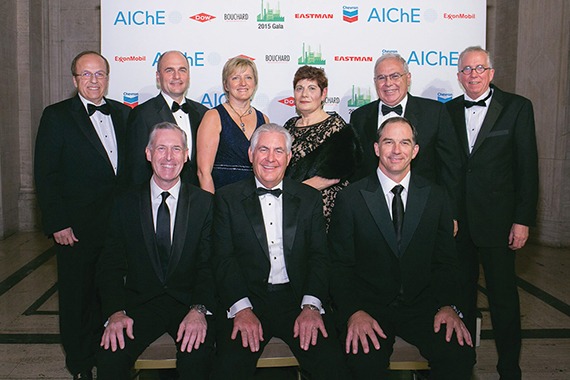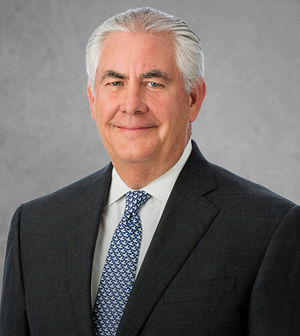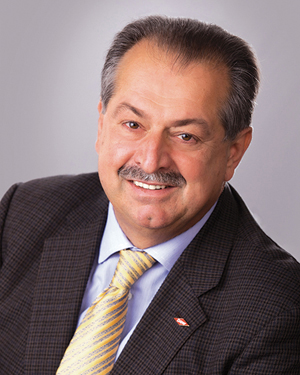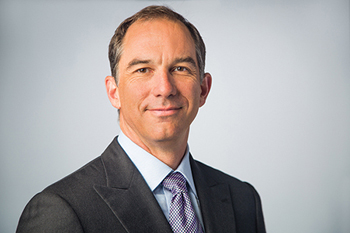This is the inaugural article of CEP’s new column, Leadership Q&A. Here, C-suite executives will discuss how they have overcome challenges, strategies for successful leadership, and tools and skills that they have found effective during their tenure, among other topics. Every other month, a different executive will focus on a new topic.
What better topic to kick off this column than process safety leadership? It is one of the most important tasks of leaders in the chemical and other processing industries — to set a culture and guide an organization to hold process safety as important as profit margins and return on investment.
Process safety is a broad topic, involving a range of tools and principles, from management of change and process hazard analysis, to dealing with reactive chemicals and designing inherently safer equipment. Many of these subjects are covered in the pages of CEP. In a recent CEP article, “Moving Process Safety into the Board Room,” (Sept. 2015, pp. 43–46), B. Karthikeyan explains that it is critical for a company’s executives and board of directors to appreciate the high-risk decisions that are being made daily at their plants. Process safety decisions, he says, should be made systematically by or under the guidance of top management.
More important than all of the process safety tools and principles are leaders who make process safety their highest priority, weave process safety principles throughout every aspect of their organization, maintain a sense of vulnerability, and appreciate that their operations involve high-risk decisions every day.
Leading the way to a safer world
In this debut Leadership Q&A column, the spotlight is on the honorees of the 2015 AIChE Gala, who were recognized for their distinguished leadership in advancing process safety in the workplace and protecting our communities: Rex Tillerson, chairman, president, and CEO of ExxonMobil; Andrew Liveris, chairman, president, and CEO of Dow Chemical; and Mark Costa, CEO of Eastman Chemical.
In selecting the honorees for the gala, the AIChE Foundation evaluated several factors related to process safety:
- overall sustained excellent process safety performance
- leadership in driving industry’s process safety performance
- recognized effort to improve process safety education
- leadership in the Center for Chemical Process Safety (CCPS), as original founders and through sustained leadership-level participation in various industry forums and organizations in support of process safety improvement
- senior leadership focus on process safety.
The 2015 AIChE Gala, Leading the Way to a Safer World, celebrated the 30-year anniversary of CCPS and raised money to support the global expansion of undergraduate process safety education, which is a core initiative of the AIChE Foundation’s Doing a World of Good fundraising campaign.
Leading in process safety education
AIChE has led the way in process safety education and awareness since its formation, most prominently through the formation of CCPS in 1985. In 1992, AIChE initiated the Safety and Chemical Engineering Education (SAChE) program, a cooperative effort of CCPS and engineering schools. SAChE provides teaching materials and programs that incorporate elements of process safety into the education of undergraduate and graduate students studying chemical and biochemical engineering. For 30 years, CCPS has been the go-to resource for industry leaders committed to identifying and addressing process safety needs within the chemical, pharmaceutical, and petroleum industries.

▲ The 2015 AIChE Gala celebrated the 30-year anniversary of CCPS and recognized the CEOs of ExxonMobil, Dow Chemical, and Eastman Chemical for their process safety leadership. Front row, left to right: James Fitterling (who accepted the award for Andrew Liveris), Rex Tillerson, and Mark Costa. Back row, left to right: John Televantos, Mark Cox, June Wispelwey, Cheryl Teich, Andreas Kramvis, and Thomas Hayes.
It is therefore no surprise that the U.S. Chemical Safety and Hazard Investigation Board (CSB) asked CCPS to develop a program to better prepare undergraduate chemical engineers for entry-level positions in industry. While progress has been made, the CSB has expressed concern that undergraduate chemical engineers should be better prepared for the industrial sector.
The CSB raised this concern after investigating the Dec. 19, 2007, explosion and fire that occurred at T2 Laboratories’ Jacksonville, FL, facility during the production of the gasoline additive methylcyclopentadienyl manganese tricarbonyl. Four employees were killed, and four other employees, as well as 28 people working at nearby businesses, were injured. CSB concluded that T2 employees did not recognize all of the potential hazards involved in designing a process for making a gasoline additive. The employees had little to no experience with reactive chemistry, although one of them held a bachelor’s degree in chemical engineering. In its report, the CSB recommended improving the education of chemical engineering students on reactive chemical hazards.
CSB called on AIChE to work with the Accreditation Board for Engineering and Technology (ABET) to include reactive hazard awareness in the college chemical engineering curriculum. AIChE, through CCPS, proposed changes to the undergraduate curriculum — requiring proficiency in all chemical hazards for chemical, biochemical, biomolecular, and similarly named engineering disciplines. The requirements were approved in October 2011.
Under the new ABET criteria, the curriculum must provide a thorough grounding in the basic sciences, including chemistry, physics, and/or biology, with some content at an advanced level. And it must include the engineering application of these basic sciences to the design, analysis, and control of chemical, physical, and/or biological processes, including the hazards associated with these processes.
Undergraduate process safety education
AIChE’s Undergraduate Process Safety Learning Initiative will create an infrastructure for chemical engineering students and educators to meet the ABET requirement. The initiative is far-reaching and lofty — within 10 years, all graduating bachelor’s level chemical engineers anywhere in the world will possess the basic process safety knowledge to have a successful and safe career. Professors will appreciate the importance of process safety and have the resources to teach it. Industry will strongly reinforce both the need for process safety and the education of professors and students. And, the chemical engineering profession will be acknowledged for the good it does in the world.
The initiative is a multipronged effort that focuses on curriculum, faculty competence, and undergraduate classes in a variety of ways:
- curriculum — updating the content and delivery of curriculum materials, including conversion to an interactive, online format; facilitating global dissemination of curricula by translating material into multiple languages
- faculty competence — expanding process safety workshops to include professors, some of whom have never worked in an industrial setting, to enhance the ability of more academicians to impart process safety knowledge to their students
- undergraduate classes — setting up process safety “boot camps” at university sites.
Funding to support the program is coming from several mechanisms, including the $612,000 raised at the gala. Chevron provided initial seed money of $100,000 for the initiative, with an additional contribution of $420,000. Dow Chemical has made a multiyear commitment of $1.21 million.
Leadership Q & A
In the next three pages, Tillerson, Liveris, and Costa provide their views on process safety, how they set the culture at their companies, the advice they wish they had been given, and a note to graduating chemical engineers on how to approach process safety with integrity.

If you had to choose one event that either changed the way you think about process safety or opened your eyes for the first time to the seriousness of process safety, what would it be?
Rex Tillerson: When I was a young engineer with the company, one of my responsibilities was to investigate serious incidents, including fatalities. I was just 27 years old, on my first supervising engineering assignment in Baytown, Texas, and we had a fatal accident at one of our facilities. As the first-line supervisor, I was asked to lead the investigation.
When you are 27 years old and investigating a death, the scenes you encounter have a lasting impact on you. This experience was particularly impactful, because the brother of the man who had died was an engineering technician who worked for me. I went through the process of having to visit the scene, and, ultimately, went with my manager to visit the family and explain to them what had happened.

It was at that point in time that safety became a core value for me.

Andrew Liveris: Immediately after graduating as a chemical engineer, I joined Dow to gain real-world experience. My on-the-job learning began, of course, with safety. Working as a production engineer — first in Australia and later in Hong Kong and Louisiana — it quickly became clear that chemical process safety was about far more than earning our license to operate. It was a personal endeavor, letting myself and my colleagues return safely at the end of the workday. It was a professional endeavor, delivering Dow’s reliable and efficient execution. And it was a source of purpose: enabling our true work of solving humanity’s most pressing problems. Even after moving into sales and management roles, I have never lost sight of that personal connection to Dow’s safety efforts.
Mark Costa: For Eastman, the aniline plant incident of 1960 is the defining incident of our corporate process safety culture. Even though it occurred long before my tenure at Eastman, I have learned and recognize that this incident serves as the lens that brings process safety issues into clear focus.
What is your role in setting the process-safety culture at your company? How has this role changed over your tenure as CEO?
Tillerson: As CEO, I know that a commitment to safety and operational integrity begins with me and the other members of the management team. Leaders influence culture by setting expectations, building structure, teaching others, and demonstrating stewardship. In fact, the first element of our safety management system is management leadership and accountability.
Throughout my tenure as CEO, I’ve learned that to effectively foster a culture of safety, you must trust and empower your employees. Our safety leadership comes not just from managers, but from employees and contractors. And they must come from every level. At ExxonMobil, we have sought to create an environment in which our employees are not only meeting the safety procedures, but they are constantly challenging them so they can be improved.
Liveris: After 40 years at Dow, I am humbled — each and every day — by the opportunity to serve at the helm of this iconic company. From day one, my greatest responsibility in this role has been keeping Dow’s people and our communities healthy and safe. That begins, of course, with process safety. In my first year as CEO, I led Dow in setting our 2015 sustainability goals, which have resulted in 1,300 fewer injuries and illnesses and 340 fewer process safety incidents over the last decade compared to a 2005 baseline.
As I visit our facilities around the world and see Dow’s human element at work, I am constantly reminded that these metrics are not just numbers; they are embodied by real people, all of whom have families and lives to return to at the end of each day. Just this year, we took Dow’s safety commitment to the next level with our 2025 sustainability goals, and we will not rest until we realize the goal of Dow’s Drive to Zero, with zero incidents, zero injuries, and zero fatalities.
Costa: My role is to set expectations, and clearly communicate that process safety is embedded in all we do. The CCPS Risk Based Process Safety (RBPS) book says it very succinctly: “Authentic commitment to process safety is the cornerstone of process safety excellence. Management commitment has no substitute. Organizations generally do not improve without strong leadership and solid commitment.”
Priorities change — process safety excellence must remain a constant, regardless of priorities. My team and I provide that leadership and commitment.
My goal is to keep up the good work we’re already doing. What I do is more a matter of maintaining our excellent process safety culture on our journey to become a specialty chemical company, rather than any fundamental shift in how we conduct ourselves.
You have a unique experience with ExxonMobil, working your way up from process engineer in 1975 to the highest level of responsibility, CEO. How has this shaped your view of process safety as well as the way you manage process safety at ExxonMobil?
Tillerson: For the past 40 years, I’ve witnessed and walked ExxonMobil’s safety journey. I’ve seen our corporate approach to safety grow and become an example for others. I have witnessed a transformation in the way people at ExxonMobil understand and think about safety.
My experience has also helped me appreciate that every employee’s job at ExxonMobil involves some level of risk management. This is true whether you are a process engineer, attorney, or the CEO. To establish a culture of safety, you have to have everyone’s participation and a system that everyone believes in.
What strategies do you use to balance process safety with delivering a high return to your stakeholders?
Tillerson: We believe that managing process safety and delivering returns to our shareholders go hand in hand. There is both a moral and a business imperative to safety. The consequences of a safety incident can go beyond the tragic loss of life to affect the business itself, the value to our shareholders, and even the broader economy.
Safety incidents demand tremendous business and financial resources to resolve when they occur. They can disrupt a facility, directly at the site, and indirectly across the business and even the entire industry. When industry fails to fulfill our fundamental responsibility to operate safely, it can undermine the confidence of the public and the trust of the regulators. This, too, carries far-reaching consequences that can be extraordinarily costly in terms of new regulations and legal requirements, and it can take years or even decades to earn back that lost respect and goodwill.
Liveris: At a time when markets, consumers, and the world at large seem to demand instant results, leaders must think and act at the “speed of live.” But, in so doing, we also have a responsibility not to lose sight of the long term. We must keep both the next quarter and the next generation front of mind. That dual-horizons mindset is a constant challenge, but it is also the only way to deliver safety progress and financial performance. Only by setting long-term safety goals and constantly holding ourselves accountable with short-term metrics can we continue to succeed as an industry. That is the core mindset behind Dow’s decade-long sustainability goals, as well as our continued efforts on behalf of critical industry initiatives like the Center for Chemical Process Safety.
Costa: Being a reliable supplier — one on whom customers can depend regardless of economic circumstances — is a cornerstone of our business strategy. Process safety incidents, large or small, tend to erode both the fact and perception of reliability.
Being successful in process safety is an integral part of being a reliable supplier, and is therefore one of the keys to Eastman becoming a preferred supplier to our customers worldwide.
How has the 1989 Valdez spill changed the way ExxonMobil operates and mitigates risks? Has it personally impacted the way you approach risk?
Tillerson: The Valdez oil spill was a turning point for the entire company. Following the spill, we set out to transform the company in the way we manage risks. We reorganized the company to put safety — of people, facilities, and the environment — at the center of everything we do. Risk management and safety would no longer be viewed as priorities, but as core values.
To implement that change, we developed a comprehensive system called the Operations Integrity Management System, or OIMS. The standards, work practices, and regular and rigorous site assessments associated with OIMS are in place today across the operations of ExxonMobil in every location around the world.
What challenges related to process safety do you face when acquiring specialty chemical companies? How do you instill the same process safety culture in these businesses?
Costa: Melding different process safety cultures is certainly a key issue when it comes to acquisition integration. The mechanistic issues associated with integration of two companies (accounting, marketing, others) are far easier to implement than the meshing of cultures. Instilling our process safety culture requires significant effort and a demonstration of commitment in terms of resources and expectations. Yet, we are uncompromising with regard to our expectations around safe design and operation and work to ensure that newly acquired sites are brought into conformance with Eastman process safety expectations.
What accomplishment related to process safety are you most proud of as CEO?
Liveris: Dow’s founder, Herbert Henry Dow, was a chemical engineer who saw the potential of our profession to innovate global solutions. I am most proud of the safety leadership Dow’s 53,000 people continue to deliver to enable that vision. That begins with our efforts within our own facilities towards eliminating process safety incidents. It extends to our work to lead the way towards better safety across our industry, sharing our tools, indices, and training materials through AIChE to help ensure that all chemical engineers have the foundation they need to operate safely.
I am also proud, of course, of Dow’s wholehearted support as a founding member of AIChE’s Undergraduate Process Safety Learning Initiative, preparing the next generation of chemical engineering professionals even before they reach the workplace.
Costa: It is always gratifying to receive the unbidden recognition of your peers, in any endeavor. Being honored alongside ExxonMobil and Dow Chemical, two giants in process safety, is a satisfying, and humbling, recognition of the quality of Eastman people in achieving and maintaining process safety performance at the highest levels.
What advice would you offer other CEOs in the oil and gas or chemical industry with regard to process safety, something you wish someone had told you?
Tillerson: Many leaders in our industry say that safety should be a top priority, but I believe that a commitment to safety must run much deeper than simply being a priority.
A company’s priorities can evolve over time depending on business conditions and other factors. A commitment to safety therefore should not be a priority, but a value that shapes decision-making all the time. Even the best safety systems are not effective unless they are part of a broader culture — the unwritten rules and norms that shape mindsets, attitudes, and, ultimately, behaviors.
Liveris: As an industry, we all have similar issues. We are all managing costs. We are all chasing margins. We are all trying to create value for our shareholders. But underpinning it all — the foundation of our industry — is doing it right and doing it safely — together. If we are going to play in this arena, we need to continue to step it up … and the data show that, although this industry has delivered a 53% drop in chemical process safety incidents over the past 30 years, our progress has stalled over the past decade.
So as we celebrate 30 years of progress, let’s do so with the knowledge that our efforts have made a difference. But let’s also acknowledge that there is more to do. Acknowledge it to ourselves first, then take it back and share that message with our teams. Tell your management. Tell your process safety engineers. Tell whoever you need to that the chemical engineering profession requires continuous safety improvement and that “good enough” is not good enough.
Costa: There are parts of my job that can be dealt with on a periodic basis — deal with it, and then let it run by itself for a while. Process safety excellence does not fit into that category. It requires constant vigilance and energy to sustain the culture and conditions necessary for excellence in execution.
Thinking back to when you entered the workforce as a newly graduated chemical engineer, how prepared were you to address process safety issues? How do you think we can better prepare chemical engineers entering the workforce with regard to process safety?
Liveris: Throughout my four decades at Dow, safety has remained core to everything we do. Before joining the company, though, it was simply one of my many priorities as a student. I think that we need to do a better job of communicating the responsibility that chemical engineers have to put safety first and foremost in our everyday work, not just for ourselves, but because of the huge power we have to change the world for the better if we get this right. This is what AIChE’s undergraduate education program is all about!
Is there anything you would like to say to chemical engineering graduates to help them approach process safety with integrity?
Tillerson: The most important asset you own is your integrity — your professional engineering integrity and your personal integrity. No one gives that to you. It’s yours, and it’s very easy to lose. I can promise that you are going to get challenged, but whatever you do, hang on to your integrity. If you ever give it up, it is extremely hard to regain. When someone pushes you, you have to stand strong.
Integrity guides us to do the right things, the right way, every time, whether anyone is looking or not. If you hold on to your integrity and make the right decisions, I promise that you will be successful in managing safety and in all aspects of your career.
Liveris: I would encourage them to never be satisfied with their current safety performance until they reach zero process safety incidents. That might sound like an unreachable goal today, but keeping it in mind as our eventual target is the only way that we can continue to lead the way to a truly safer world.
Costa: To new ChE graduates, I would tell them to remember this throughout their career: Success in business is dependent upon success in process safety. This is an and concept, not an or concept. You cannot, and will not, have one over the long term without the other.
Feedback Welcome
Editor Note: Let us know what you think of the new column and what topics you would like us to explore. Contact the CEP editors at: michb@aiche.org.

Copyright Permissions
Would you like to reuse content from CEP Magazine? It’s easy to request permission to reuse content. Simply click here to connect instantly to licensing services, where you can choose from a list of options regarding how you would like to reuse the desired content and complete the transaction.
